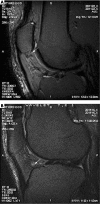Synovitis detected on magnetic resonance imaging and its relation to pain and cartilage loss in knee osteoarthritis
- PMID: 17491096
- PMCID: PMC2095318
- DOI: 10.1136/ard.2006.067470
Synovitis detected on magnetic resonance imaging and its relation to pain and cartilage loss in knee osteoarthritis
Abstract
Objective: To examine the relationship between longitudinal fluctuations in synovitis with change in pain and cartilage in knee osteoarthritis.
Methods: Study subjects were patients 45 years of age and older with symptomatic knee osteoarthritis from the Boston Osteoarthritis of the Knee Study. Baseline and follow-up assessments at 15 and 30 months included knee magnetic resonance imaging (MRI), BMI and pain assessment (VAS) over the last week. Synovitis was scored at 3 locations (infrapatellar fat pad, suprapatellar and intercondylar regions) using a semiquantitative scale (0-3) at all 3 time points on MRI. Scores at each site were added to give a summary synovitis score (0-9).
Results: We assessed 270 subjects whose mean (SD) age was 66.7 (9.2) years, BMI 31.5 (5.7) kg/m(2); 42% were female. There was no correlation of baseline synovitis with baseline pain score (r = 0.09, p = 0.17). The change in summary synovitis score was correlated with the change in pain (r = 0.21, p = 0.0003). An increase of one unit in summary synovitis score resulted in a 3.15-mm increase in VAS pain score (0-100 scale). Effusion change was not associated with pain change. Of the 3 locations for synovitis, changes in the infrapatellar fat pad were most strongly related to pain change. Despite cartilage loss occurring in over 50% of knees, synovitis was not associated with cartilage loss in either tibiofemoral or patellofemoral compartment.
Conclusions: Change in synovitis was correlated with change in knee pain, but not loss of cartilage. Treatment of pain in knee osteoarthritis (OA) needs to consider treatment of synovitis.
Conflict of interest statement
Competing interests: None declared.
References
-
- Dye S F, Vaupel G L, Dye C C. Conscious neurosensory mapping of the internal structures of the human knee without intraarticular anesthesia. Am J Sports Med 1998261–4. - PubMed
-
- Schaible H G, Grubb B D. Afferent and spinal mechanisms of joint pain. Pain 1993555–54. - PubMed
-
- Smith M D, Wetherall M, Darby T, Esterman A, Slavotinek J, Roberts‐Thomson P.et al A randomized placebo‐controlled trial of arthroscopic lavage versus lavage plus intra‐articular corticosteroids in the management of symptomatic osteoarthritis of the knee. Rheumatology (Oxford) 2003421477–1485. - PubMed
Publication types
MeSH terms
Grants and funding
LinkOut - more resources
Full Text Sources
Other Literature Sources
Medical


